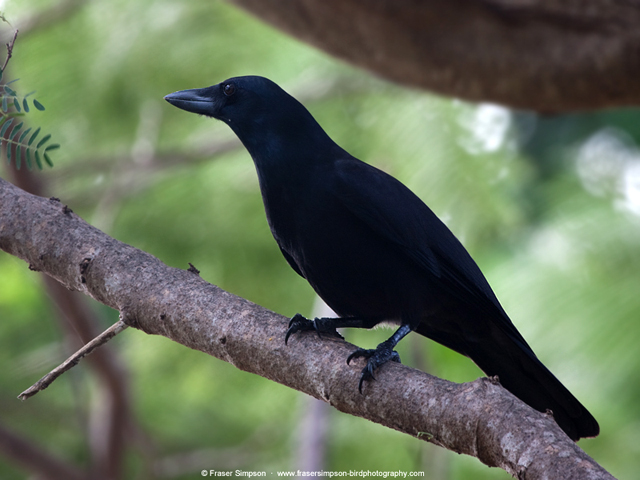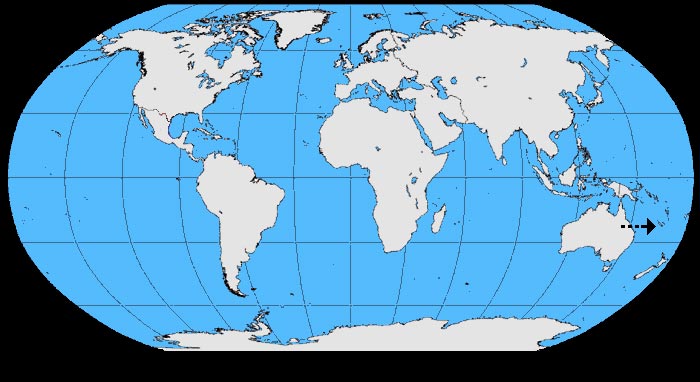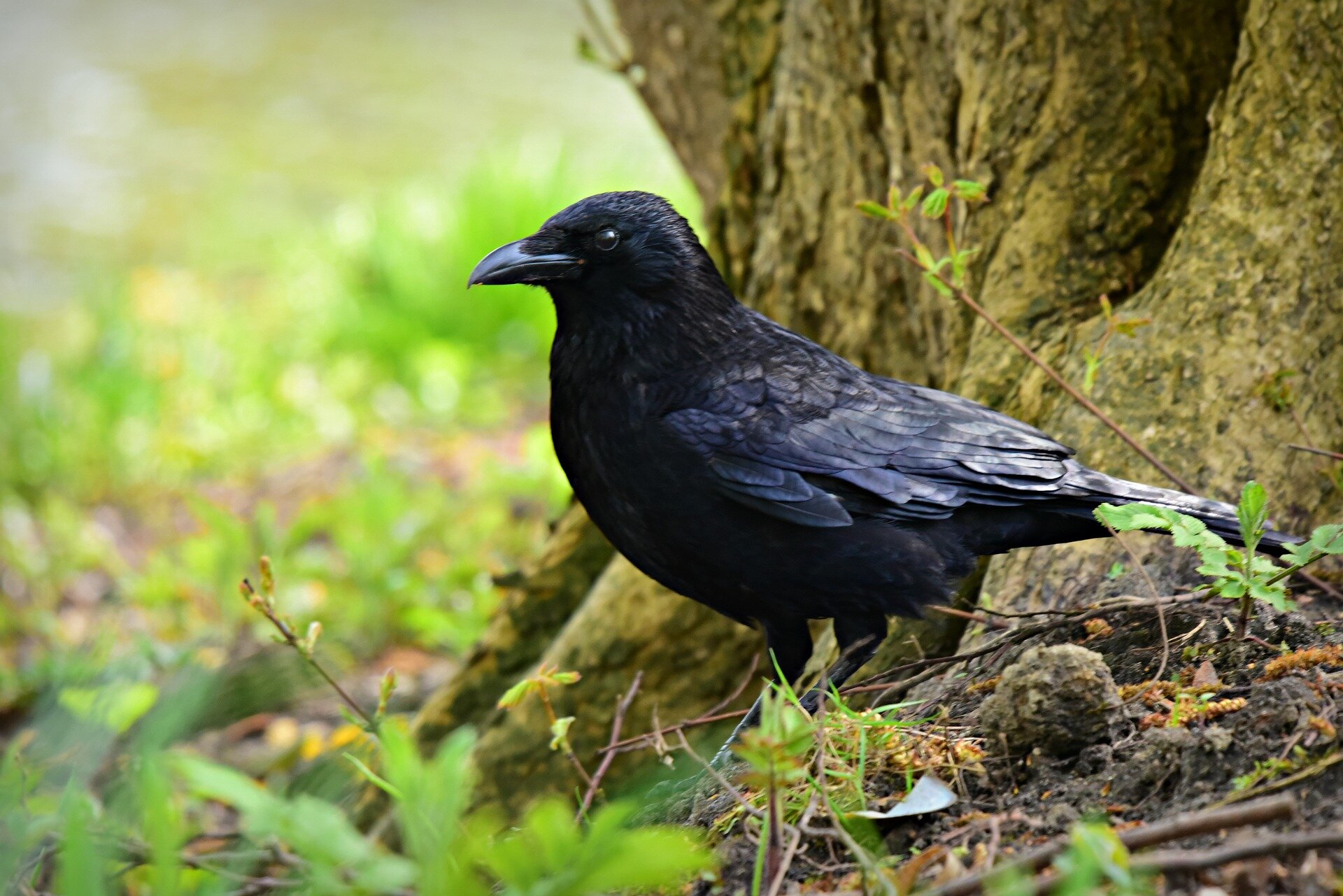Post by Eaglehawk on Aug 24, 2019 4:55:22 GMT
New Caledonian Crow - Corvus moneduloides

Scientific classification
Kingdom: Animalia
Phylum: Chordata
Class: Aves
Order: Passeriformes
Family: Corvidae
Genus: Corvus
Species: Corvus moneduloides
The New Caledonian Crow (Corvus moneduloides) is a tool-using species of crow endemic to New Caledonia and the Loyalty Islands. These crows are the only non-primate animals known to invent new tools by modifying existing ones, and then passing these innovations on to other individuals in the cultural group. They have also been seen making tools that they use in the wild out of completely different material.
Distribution and habitat
The bird is endemic to the island of New Caledonia and the Loyalty Islands in the Pacific, living in primary forest.

Description
The New Caledonian Crow (Corvus moneduloides) is a moderately sized crow (40 cm in length) similar in size to the House Crow but less slender looking. The bird is all black with a rich gloss to the feathers of purple, dark blue and some green in good light. The beak, feet and legs are all black too. The beak is of moderate size but is unusual in that the tip of the lower is angled up making it somewhat chisel-like in profile.
The ability to fashion tools had always been held as unique to primates, distinguishing humans and their closest relatives from (apparently) less intelligent creatures. But humans and apes are not alone in having tool-making skills. Crows amazed the science community when footage recorded using tiny "crow-cams" on the tails of New Caledonian crows showed the birds creating advanced implements. One crow was observed whittling twigs and leaves with its beak to fashion grabbers designed to retrieve grubs from the ground. The New Caledonian crows are the only known non-primate to create and use new tools
The voice is described as a soft waa-waa or wak-wak, sometimes a hoarse waaaaw.
Ecology and behavior
It eats a very wide range of food including many types of insects and other invertebrates (some caught in flight with some agility, including night-flying insects which it catches at dusk), eggs and nestlings, snails (which it drops from a height onto hard stones), and various nuts and seeds. It is known for using plant material to create hooks or barbs for extracting grubs from inside logs and branches. This bird fills in the ecological niche of the woodpeckers and the Woodpecker Finch of the Galapagos, since the latter and New Caledonia lack woodpeckers. Unlike the Woodpecker Finch, however, it does not simply stab a grub and lever it slowly out of its log using a small twig but pokes the twig at the grub to agitate it into biting the twig. It shows great ingenuity in the search for food.
Its nest is built high in a tree with usually only 2 eggs laid from September to November.
Tool making
The New Caledonian Crow is the only non-human species with a record of inventing new tools by modifying existing ones, then passing these innovations to other individuals in the cultural group. Gavin R. Hunt and colleagues at the University of Auckland studied tools the crows make out of pandanus (or screw pine) leaves:
Crows snip into the leaf edges and then tear out neat strips of vegetation with which they can probe insect-harboring crevices. These tools have been observed to come in three types: narrow strips, wide strips and multi-stepped strips—which are wide at one end and, via a manufacturing process that involves stepwise snips and tears, become narrow at the opposite end.
Observations of the distribution of 5,500 leaf counterparts or stencils left behind by the cutting process suggest that the narrow and the stepped tools are more advanced versions of the wide tool type. "The geographical distribution of each tool type on the island suggests a unique origin, rather than multiple independent inventions". This implies that the inventions, which involve a delicate change in the manufacturing process, were being passed from one individual to another.
The New Caledonian Crow also spontaneously makes tools from materials it does not encounter in the wild, the only non-human species known to do so. In 2002, researcher Kacelnik and colleagues at the University of Oxford observed of a couple of New Caledonian Crows called Betty and Abel:
Betty's toolmaking abilities came to light by accident during an experiment in which she and Abel had to choose between a hooked and a straight wire for retrieving small pieces of pig heart, their favorite food. When Abel made off with the hooked wire, Betty bent the straight wire into a hook and used the tool to lift a small bucket of food from a vertical pipe. This experiment was the first time the crows had been presented with wire.
Subsequently, this ability was tested through a series of systematic experiments. Out of ten successful retrievals, Betty bent the wire into a hook nine times. Abel retrieved the food once, without bending the wire. The process would usually start with Betty trying to get the food bucket with the straight wire, but then she would make a hook from it bending it in different ways, usually by snagging one end of the wire under something, and then using the bent hook to pick up the tray.
Clearly, Betty's creation of hooks cannot be attributed to the shaping or reinforcement of randomly generated behavior. In 2004, Gavin Hunt observed the crows in the wild also making hooks, but the adaptation to the new material of the wire was clearly novel, and also purposeful. This type of intentional tool-making, even if it is generalizing a prior experience to a completely new context, is almost unknown in the animal world. Chimpanzees have great difficulty in similar innovative tasks.
Meta-tool use
Recent experiments show that New Caledonian Crows are able to use one tool to affect another to achieve a task, at a level rivalling the best performances seen in primates.
The experiment was conducted by the Auckland team and involved putting food in a box out of reach of the crows. They were given a stick too short to reach the food, but they could use this to retrieve a longer stick from another box. The longer stick was then used to retrieve the food. This complex behaviour involved realising that a tool could be used on non-food objects, and suppressing the urge to go directly for the food. It was solved by six of seven birds on the first attempt, and had previously only been known in primates.

Scientific classification
Kingdom: Animalia
Phylum: Chordata
Class: Aves
Order: Passeriformes
Family: Corvidae
Genus: Corvus
Species: Corvus moneduloides
The New Caledonian Crow (Corvus moneduloides) is a tool-using species of crow endemic to New Caledonia and the Loyalty Islands. These crows are the only non-primate animals known to invent new tools by modifying existing ones, and then passing these innovations on to other individuals in the cultural group. They have also been seen making tools that they use in the wild out of completely different material.
Distribution and habitat
The bird is endemic to the island of New Caledonia and the Loyalty Islands in the Pacific, living in primary forest.

Description
The New Caledonian Crow (Corvus moneduloides) is a moderately sized crow (40 cm in length) similar in size to the House Crow but less slender looking. The bird is all black with a rich gloss to the feathers of purple, dark blue and some green in good light. The beak, feet and legs are all black too. The beak is of moderate size but is unusual in that the tip of the lower is angled up making it somewhat chisel-like in profile.
The ability to fashion tools had always been held as unique to primates, distinguishing humans and their closest relatives from (apparently) less intelligent creatures. But humans and apes are not alone in having tool-making skills. Crows amazed the science community when footage recorded using tiny "crow-cams" on the tails of New Caledonian crows showed the birds creating advanced implements. One crow was observed whittling twigs and leaves with its beak to fashion grabbers designed to retrieve grubs from the ground. The New Caledonian crows are the only known non-primate to create and use new tools
The voice is described as a soft waa-waa or wak-wak, sometimes a hoarse waaaaw.
Ecology and behavior
It eats a very wide range of food including many types of insects and other invertebrates (some caught in flight with some agility, including night-flying insects which it catches at dusk), eggs and nestlings, snails (which it drops from a height onto hard stones), and various nuts and seeds. It is known for using plant material to create hooks or barbs for extracting grubs from inside logs and branches. This bird fills in the ecological niche of the woodpeckers and the Woodpecker Finch of the Galapagos, since the latter and New Caledonia lack woodpeckers. Unlike the Woodpecker Finch, however, it does not simply stab a grub and lever it slowly out of its log using a small twig but pokes the twig at the grub to agitate it into biting the twig. It shows great ingenuity in the search for food.
Its nest is built high in a tree with usually only 2 eggs laid from September to November.
Tool making
The New Caledonian Crow is the only non-human species with a record of inventing new tools by modifying existing ones, then passing these innovations to other individuals in the cultural group. Gavin R. Hunt and colleagues at the University of Auckland studied tools the crows make out of pandanus (or screw pine) leaves:
Crows snip into the leaf edges and then tear out neat strips of vegetation with which they can probe insect-harboring crevices. These tools have been observed to come in three types: narrow strips, wide strips and multi-stepped strips—which are wide at one end and, via a manufacturing process that involves stepwise snips and tears, become narrow at the opposite end.
Observations of the distribution of 5,500 leaf counterparts or stencils left behind by the cutting process suggest that the narrow and the stepped tools are more advanced versions of the wide tool type. "The geographical distribution of each tool type on the island suggests a unique origin, rather than multiple independent inventions". This implies that the inventions, which involve a delicate change in the manufacturing process, were being passed from one individual to another.
The New Caledonian Crow also spontaneously makes tools from materials it does not encounter in the wild, the only non-human species known to do so. In 2002, researcher Kacelnik and colleagues at the University of Oxford observed of a couple of New Caledonian Crows called Betty and Abel:
Betty's toolmaking abilities came to light by accident during an experiment in which she and Abel had to choose between a hooked and a straight wire for retrieving small pieces of pig heart, their favorite food. When Abel made off with the hooked wire, Betty bent the straight wire into a hook and used the tool to lift a small bucket of food from a vertical pipe. This experiment was the first time the crows had been presented with wire.
Subsequently, this ability was tested through a series of systematic experiments. Out of ten successful retrievals, Betty bent the wire into a hook nine times. Abel retrieved the food once, without bending the wire. The process would usually start with Betty trying to get the food bucket with the straight wire, but then she would make a hook from it bending it in different ways, usually by snagging one end of the wire under something, and then using the bent hook to pick up the tray.
Clearly, Betty's creation of hooks cannot be attributed to the shaping or reinforcement of randomly generated behavior. In 2004, Gavin Hunt observed the crows in the wild also making hooks, but the adaptation to the new material of the wire was clearly novel, and also purposeful. This type of intentional tool-making, even if it is generalizing a prior experience to a completely new context, is almost unknown in the animal world. Chimpanzees have great difficulty in similar innovative tasks.
Meta-tool use
Recent experiments show that New Caledonian Crows are able to use one tool to affect another to achieve a task, at a level rivalling the best performances seen in primates.
The experiment was conducted by the Auckland team and involved putting food in a box out of reach of the crows. They were given a stick too short to reach the food, but they could use this to retrieve a longer stick from another box. The longer stick was then used to retrieve the food. This complex behaviour involved realising that a tool could be used on non-food objects, and suppressing the urge to go directly for the food. It was solved by six of seven birds on the first attempt, and had previously only been known in primates.



